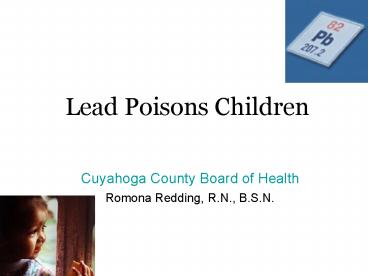Lead Poisons Children - PowerPoint PPT Presentation
1 / 27
Title:
Lead Poisons Children
Description:
In the city of East Cleveland approximately 20% of the children tested in 2003 ... Has a sibling or playmate that has or did have lead poisoning ... – PowerPoint PPT presentation
Number of Views:56
Avg rating:3.0/5.0
Title: Lead Poisons Children
1
Lead Poisons Children
- Cuyahoga County Board of Health
- Romona Redding, R.N., B.S.N.
2
How many children are lead poisoned?
3
(No Transcript)
4
(No Transcript)
5
The Cuyahoga County Picture
- Approximately 10.5 or 2654 children living in
Cuyahoga County tested in 2003 were lead
poisoned. - In the city of Cleveland approximately 13.5 of
the children tested in 2003 were lead poisoned
(2,249). - In the city of East Cleveland approximately 20
of the children tested in 2003 had elevated blood
were lead poisoned (177). - Source 2003 Annual ODH Data
6
(No Transcript)
7
(No Transcript)
8
(No Transcript)
9
How is lead poisoning defined?
10
Lead Poisoning Defined
- Lead is measured in micrograms/deciliter or ug/dl
in blood. - Centers for Disease Control and Prevention has
changed definition level several times. - Currently children are considered to be lead
poisoned at 10 ug/dL of blood (CDC 1991). - Research shows that damage may begin at levels as
low as 5 ug/dl.
11
Lead Poisons
- There is no safe level of lead in the human body.
- Lead accumulates in the brain, kidneys, blood,
and bones. - Lead poisoning causes learning disabilities,
hearing problems, language delays, and behavioral
problems. - High levels of lead can cause seizures, coma, and
death.
12
Symptoms
- Headache
- Stomachache
- Vomiting
- Hyperactivity
- Sleep disturbances
- Irritability
- Clumsiness
- Lack of appetite
- Most children do not show symptoms!
13
Testing Methods
- Venous Sampling (blood draw)
- Preferred testing method
- More accurate
- One test confirms all results
- Capillary Sampling (fingerstick)
- Can have false highs from surface contamination
and concentration from milking the finger. - One test confirms results lt10 ug/dL.
- Two tests needed to confirm result 10 ug/dL or
greater.
14
Poisoning Classifications
- 0-9 ug/dl below level of concern
- 10-14 ug/dl low toxicity
- 15-19 ug/dl mild toxicity
- 20-44 ug/dl moderate toxicity
- 45-69 ug/dl high toxicity
- gt70 ug/dl severe toxicity, medical emergency
15
Lead Poisoning Treatment
- Children are not generally treated with
medication until levels reach at least 45 ug/dl. - Treated with chelation medication.
- Given orally outpatient or IV inpatient.
- Medication rapidly decreases lead levels.
- Levels rebound after decline, but usually not as
high as initial level. - Regular follow-up is pertinent in determining
that lead levels continually decline. - Medication can be nephrotoxic or damaging to
kidneys. - Once a child is lead poisoned, treatment has not
been shown to reduce risks of long-term problems,
prevention of lead poisoning is best. - Unless a childs lead level is 45 or greater the
best treatment is to reduce or eliminate lead
exposure.
16
Who is at risk?
17
Child at risk of lead poisoningOAC 3701-30
- Any child under the age of six who meets one or
more of the following - Medicaid eligible.
- Lives in a high risk zip code.
- Lives in or regularly visits a residential unit,
childcare facility, or school built before 1950. - Lives in or regularly visits a residential unit
built before 1978 with recent ongoing or planned
renovation/remodeling. - Has a sibling or playmate that has or did have
lead poisoning - Frequently comes in contact with an adult who has
a lead-related hobby or occupation.
18
Children up to 5 years old are at highest risk
- Peak exposure ages are 1 and 2.
- Why?
- Beginning to be mobile.
- Have normal hand-to-mouth behaviors.
- Rapid growth and development period and their
bodies will absorb more lead than older children
and adults. - Children with nutritional deficits in iron,
calcium, and/or zinc may be at higher risk for
lead poisoning.
19
Minority Children
- Minority children
- For example, 22 of black children and 13 of
Mexican-American children living in housing built
before 1946 have elevated blood lead levels
compared with 6 of white children living in
comparable types of housing (source CDC).
20
Medicaid Children
- Estimates by NHANES (1991-1994) Medicaid
enrollees accounted for - -60 of children with lead levels 10 ug/dL or
greater. - -83 of children with lead levels 20 ug/dL or
greater.
21
Children in High-risk Zip Codes
- Children in certain geographic locations are at
increased risk for lead exposure. - Current high risk zip codes include
- Cleveland
- Cleveland Heights
- East Cleveland
- Garfield Heights (44105)
- Shaker Heights
- Lakewood
- Bedford, Bedford Heights, Oakwood
O
22
Poisoning can happen before birth
- 95 of lead is absorbed into the bones.
- Lead can be mobilized by the nutritional demands
of pregnancy. - Lead can cross the placenta as early as the 12th
week of gestation. - Children who are poisoned inutero can have same
long-term effects as other children. - Supplementation of calcium, zinc, and iron is
very important to prevent lead mobilization in
women with a history of lead poisoning.
23
When should children be tested?
24
Medicaid Children
- Children on Medicaid, Healthy Families, or
Healthy Start are federally mandated to be lead
tested at ages 1 2.
25
Children at risk of lead poisoning
- Mandated by state law that children are tested
before age 6. - Recommended that children are tested at ages 1
2 and every year as medically indicated.
26
Prevention
- Educate and raise awareness about lead poisoning,
lead sources, testing, and local resources.
27
Help End Childhood Lead Poisoning!































